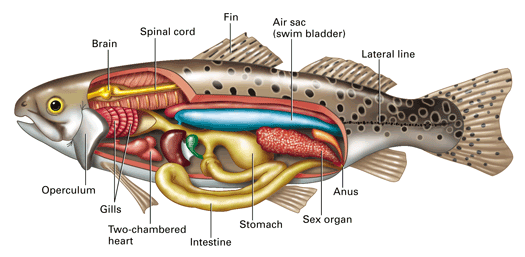Fish Heart Chambers Diagram | A schematic diagram of the three main phases of filling and emptying of four cardiac chambers of the fish heart. The heart is situated at the base of the throat and lies in the pericardial cavity that is completely separated from the body cavity. They only have single circulation of blood and definitely possess the lowest pressure and least advanced heart. Human heart • four chambers • double circuit • oxygen poor blood is pumped from the right side of the heart to the lungs where it is oxygenated. When the pharynx is filled, the mouth closes and the gill chambers expand and fill with water. The heart of fishes consists of four chambers, a sinus venosus, an atrium, a ventricle and a conus or a bulbus arteriosus (fig. It consists of a heart, blood, and blood vessels. (b) the atrium contracts (as shown by the small arrows), further expanding and completing the filling of the ventricle. • blood flows next into the most obvious and muscular chamber, the ventricle. The ventricle, however, remains as a single chamber. The circulatory system of fish is quite simple. The receiving chambers (sinus venosus and auricle) receive the venous blood from all parts of the body. It is located low in the fish between the gills. 2 chambers, amphibians and reptiles: • blood flows next into the most obvious and muscular chamber, the ventricle. Look at the diagrams and follow in your shark the passage of water in the mouth and spiracles (which have a one way valve) and through the five gill slits. An updated version of this vi. The venous side of the heart is preceded by an enlarged chamber called the sinus venosus. It consists of a heart, blood, and blood vessels. An atrium and a ventricle. Blood then is returned to the heart. The arterial side of the heart is followed by a thickened muscular cavity called the bulbus arteriosus. They only have single circulation of blood and definitely possess the lowest pressure and least advanced heart. The heart pumps the blood in a single loop throughout the body. The most important organ of the circulatory system is the heart and in fish has a tubular and straight structure that is divided into four parts, called the venous sinus, atrium, ventricle, and arterial cone. Human, fish and reptile heart. 2 chambers, amphibians and reptiles: Their heart consists of four parts: But unlike us, the chambers of their heart are not all muscular and are not so built into a single organ. Human, fish and reptile heart. The circulatory system of fish is quite simple. But now in addition, the single atrium becomes divided into two. Of the vertebrates, or animals with a backbone, fish have the simplest type of heart and is considered the next step in the evolutionary chain. The right atrium receives blood from the veins and pumps it to the right ventricle. It is an oval chamber and constitutes the most prominent part of the heart. The venous side of the heart is preceded by an enlarged chamber called the sinus venosus. Diagram's of the circulatory system. There is thus only one atrium and one ventricle in the mature fish heart. This is known as single cycle circulation. An atrium and a ventricle. When the pharynx is filled, the mouth closes and the gill chambers expand and fill with water. The atrium also is best seen by lifting the main portion of the heart. Human, fish and reptile heart. The circulatory system of fish is quite simple. Bulging out to the sides. The heart of fish is therefore only a single pump (consisting of two chambers). The heart pumps the blood in a single loop throughout the body. Birds have a much higher metabolic rate than humans. The top is called the atrium and the bottom chamber is called the ventricle. Look at the diagrams and follow in your shark the passage of water in the mouth and spiracles (which have a one way valve) and through the five gill slits. The heart, as well as the entire circulatory system, are unevolvable in a step by step manner. Blood then is returned to the heart. Of the vertebrates, or animals with a backbone, fish have the simplest type of heart and is considered the next step in the evolutionary chain. A loop from the heart goes to the pulmonary capillary beds, where gas exchange occurs. The heart is situated at the base of the throat and lies in the pericardial cavity that is completely separated from the body cavity. It is an oval chamber and constitutes the most prominent part of the heart. (b) the atrium contracts (as shown by the small arrows), further expanding and completing the filling of the ventricle. For example, the first layer, the venous. The circulatory system of fish is quite simple.


The conus arteriosis contains a series of semilunar valves that direct the blood flow fish heart chamber. Given a 2 chambered heart, experts do not know when, how, or in what lineage the alleged transition from the 2 chamber fish heart to the 3 chambered
Fish Heart Chambers Diagram: In amphibians, such a tube heart stage also occurs in development, along with a very specific folding that also occurs in the fish.

EmoticonEmoticon